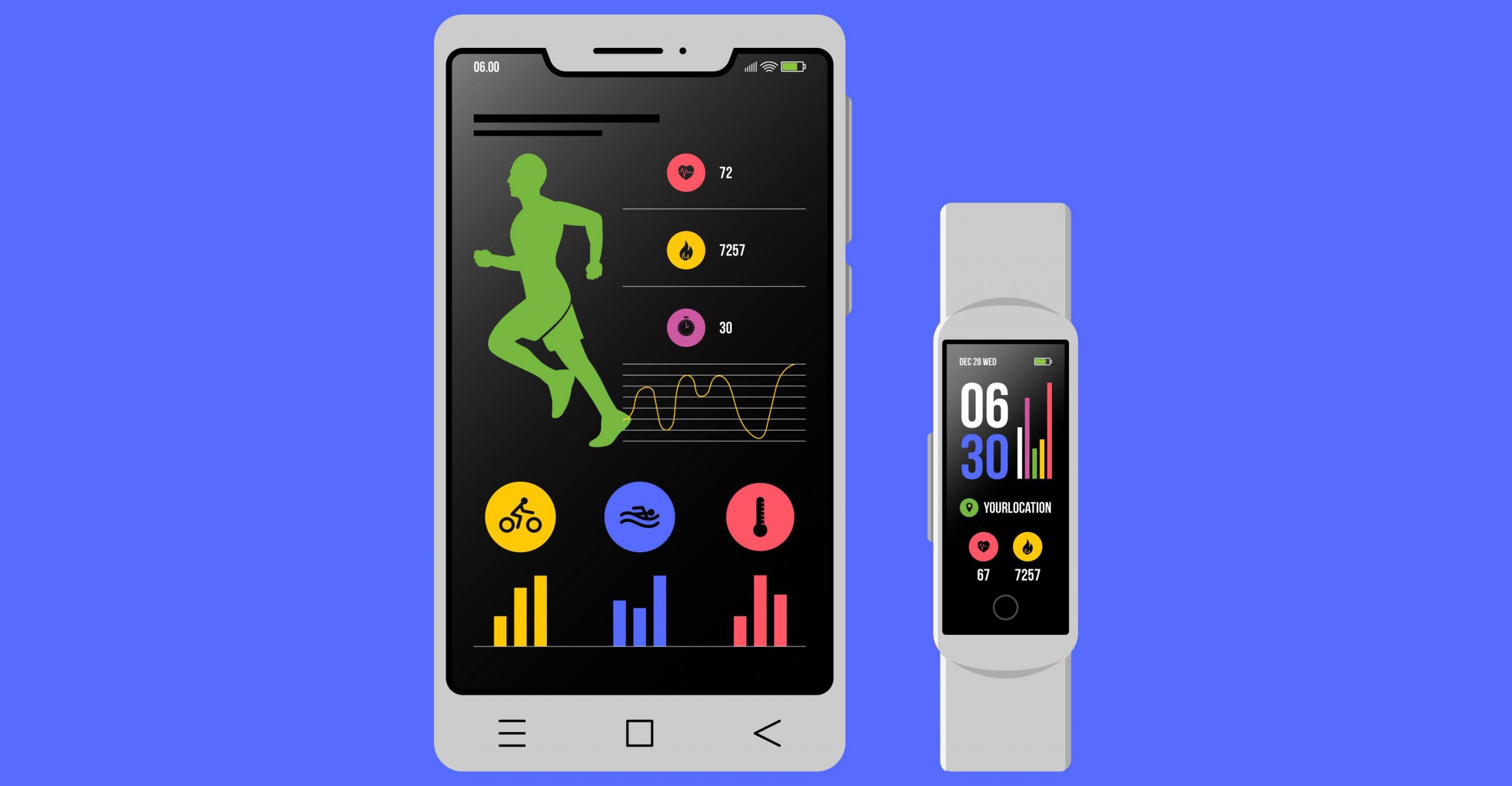Wearable health technology has swiftly emerged as an innovative force in fitness and wellness. The objectives behind it went beyond mere gadgets to devices aiming to revolutionize how individuals engage with their health. Wearable health tech is an example of innovation in healthcare by fostering health awareness, facilitating self-checkups, and empowering people to navigate medical emergencies. In this article, we will examine the multifaceted impact of wearable health technology on fitness and wellness, decoding its diverse functionalities and real-world implications.
Table of Contents
Understanding Wearable Health Technology
The discovery of wearable health technology begins with a basic understanding of its intricacies and types. These cutting-edge devices range from basic pedometers to sophisticated smartwatches, each uniquely designed to accommodate an individual’s health needs. The evolution of wearable health tech has been incredible, transitioning from simple step counters to comprehensive health companions.
These devices have various features extending far beyond basic activity tracking. Heart rate monitoring, sleep analysis, stress management, and nutrition tracking are examples of modern wearables’ capabilities. By consistently integrating technology into our daily lives, wearable health devices have become essential tools for those seeking to optimize their fitness and wellness journeys.

The Impact of Wearable Health Tech on Fitness
Monitoring Physical Activity: Step Counters and Beyond
At the forefront of wearable health technology’s impact on fitness lies its ability to monitor physical activity. Once a novel addition to our wristwear, step counters have evolved into sophisticated trackers capable of quantifying our every move. Transitioning from steps to active minutes, distance, and even floors climbed, these wearables incentivize movement and elevate physical activity awareness.
Yet, wearable health tech continues beyond what we’ve just presented. Real-time workout tracking takes the stage, allowing individuals to gauge the intensity and effectiveness of their exercises. With a tap on the touchscreen, users can dive into detailed insights about heart rate zones, calories burned, and exercise duration. This active feedback loop empowers users to fine-tune their workouts, maximizing their fitness gains.
Personalized Fitness Recommendations and Goal Setting
In this age of personalized experiences, wearable health tech is a leader in individualized fitness. These devices utilize the wealth of data they collect to offer tailored recommendations and set achievable goals. Through machine learning algorithms, wearables analyze user behavior and patterns to suggest workout routines, dietary adjustments, and sleep optimization strategies.
Improving Wellness Through Wearable Health Tech
Tracking Sleep Patterns and Sleep Quality
beyond fitness, wearable health technology extends its reach to the wellness field by addressing one of the pillars of a healthy lifestyle: sleep. Sleep tracking features embedded within these devices offer insights into sleep duration, sleep cycles, and overall sleep quality. With these details, individuals can make informed decisions to improve their sleep quality and enjoy restful nights.
Stress and Relaxation Management with Biofeedback
In our fast-paced modern life, managing stress and finding moments of relaxation can be challenging. Wearable health tech introduces a solution through biofeedback mechanisms. These devices monitor heart rate variability, a key indicator of stress levels, and provide real-time feedback on relaxation techniques, leading to accessible tools for mental well-being like Guided breathing exercises and mindfulness prompts.
Nutrition Monitoring and Dietary Insights
No wellness journey is complete without addressing nutrition. Wearable health technology offers a new dimension to dietary awareness by tracking eating habits and providing insights into nutritional intake. Some advanced wearables even utilize image recognition technology to identify food items and estimate calorie counts. This data-driven approach empowers individuals to make informed dietary choices, promoting a well-rounded approach to wellness.

Wearable Health Tech and Health Monitoring
Continuous Health Monitoring: Heart Rate, Blood Pressure, and More
Integrating health monitoring capabilities into wearable devices has ushered in a new era of personalized healthcare service. The constant monitoring of vital signs, such as heart rate and blood pressure, gives individuals real-time insights into their physiological well-being. This preemptive approach allows for the early detection of anomalies and empowers users to take timely action.
Early Detection of Health Issues and Medical Alerts
Wearable health tech monitors and alerts users to potential health concerns. Irregular heart rate patterns, abnormal blood pressure readings, and sudden changes in activity levels can trigger notifications, prompting individuals to seek medical attention. This early detection system can be critical in preventing and managing chronic conditions.
Remote Patient Monitoring and Telemedicine
Wearable health technology extends beyond personal use to professional use by healthcare providers. Remote patient monitoring enables medical professionals to track patients’ health metrics and adjust treatment plans remotely. Telemedicine consultations are facilitated through wearables, and there is no geographical bridge that restricts accessible healthcare services to individuals in remote or underserved areas.
Challenges and Considerations
Data Privacy and Security Concerns
While wearable health technology offers many benefits, it raises reasonable data privacy and security concerns. Collecting and storing personal health data requires robust measures to safeguard sensitive information. Keeping a balance between seamless data flow and strict privacy protocols is a challenge that users and manufacturers must navigate.
User Adherence and Behavior Change
The effectiveness of wearable health tech relies mainly on user adherence and behavior change; encouraging individuals to wear and engage with these devices consistently can be challenging. Moreover, transforming health behaviors requires more than just data; it necessitates fostering meaningful behavior change through personalized insights and actionable guidance.
Integration with Healthcare Systems and Professional Guidance
The integration of wearable health technology into existing healthcare systems poses logistical challenges. Ensuring seamless data exchange between wearables and electronic health records and establishing clear communication channels between individuals and healthcare professionals demands combined efforts. Additionally, wearable data should complement, not replace, medical expertise.
Future Trends and Innovations
Advancements in Sensor Technology and Data Accuracy
The evolution of wearable health technology shows no signs of slowing down. Innovations in sensor technology promise enhanced data accuracy and granularity. From more precise heart rate monitoring to real-time hydration tracking, these advancements enable wearables to provide increasingly detailed insights into our health and well-being.
Artificial Intelligence and Machine Learning in Wearable Health Tech
Artificial intelligence and machine learning are expected to play a pivotal role in the future of wearable health tech. They can analyze big amounts of data to uncover hidden patterns and correlations. By learning from individual behaviors and health metrics, wearables powered by AI/ML can offer predictive insights and personalized recommendations that guide users toward healthier choices.
Hybrid Wearables: Merging Fashion with Functionality
The mix of fashion and functionality is a natural progress for wearable health technology. Hybrid wearables seamlessly blend health monitoring features with stylish designs, making them more appealing to a broader audience. These devices can seamlessly transition from fitness tracking during the day to elegant accessories for social occasions, removing the stigma often associated with traditional health tech.
Choosing the Right Wearable Health Device
Factors to Consider When Selecting a Wearable Device
The selection of a wearable health device is a decision that requires careful consideration. Your fitness goals, health needs, and lifestyle preferences should guide your choice. Assess whether you prioritize features like heart rate monitoring, sleep tracking, or GPS functionality. Battery life, compatibility with your smartphone, and water resistance are valuable factors that should influence your decision.
Popular Brands and Their Unique Offerings
When it comes to wearable health technology, many brands have stepped onto the stage, each with unique offerings designed to cater to diverse health and lifestyle needs. Let’s look closely at some of these popular brands and what sets their wearable devices apart.
Apple
As a technological powerhouse, Apple has made its mark in the wearable health tech arena with its Apple Watch series. These smartwatches go beyond simply telling time, integrating various health and fitness features. The Apple Watch includes:
- An optical heart rate sensor.
- An ECG app for monitoring heart rhythm.
- A dedicated Fitness app that offers a wide range of workout tracking options.
The seamless integration with the Apple Health app on iOS devices creates a holistic health ecosystem that syncs data from various sources, providing users comprehensive insights into their well-being.
Fitbit
Fitbit is synonymous with fitness trackers and has carved out a niche as a pioneer in wearable health technology. Fitbit devices offer a range of models, from basic activity trackers to advanced smartwatches. Fitbit’s unique offering lies in its focus on motivating behavior change. Fitbit instruments inspire users to set and achieve fitness goals through challenges, badges, and personalized guidance. Sleep tracking, heart rate monitoring, and guided breathing exercises are among the features that contribute to Fitbit’s comprehensive approach to wellness.
Samsung
Samsung’s Galaxy Watch series showcases the brand’s commitment to wearable health technology. These smartwatches have various health-focused features, including heart rate monitoring, sleep tracking, and stress management. What sets Samsung apart is its integration of advanced sensors, such as blood pressure monitoring and ECG functionality (where available). The Galaxy Watch also boasts a variety of fitness tracking modes and a robust ecosystem of apps that cater to health and wellness enthusiasts.
Garmin
Garmin has made a name for itself by catering to the needs of outdoor enthusiasts and athletes. The brand’s wearable health devices, such as the Garmin Venu series, offer robust fitness and wellness features. Beyond standard health metrics, Garmin devices provide specialized modes for various sports and outdoor activities and even advanced training metrics for runners and cyclists. These devices are favored by those who seek in-depth insights into their workouts and performance.
Whoop
Whoop stands out as a brand focused exclusively on health and performance optimization. The Whoop Strap is a subscription-based wearable emphasizing recovery, sleep, and strain management. With a heavy emphasis on analytics, Whoop users receive detailed data on their sleep cycles, recovery status, and the impact of different activities on their bodies. This specialized approach caters to athletes and individuals looking to fine-tune their training routines for optimal results.
Embracing a Healthier Future with Wearable Health Technology
In conclusion, wearable health technology isn’t merely about the devices we wear; it’s about the journeys we embark upon. It’s about using technology to elevate our understanding of our bodies, making conscious choices to enhance our physical well-being, and embracing a proactive approach to health management. By embracing wearable health tech, we are stepping into a world where empowerment meets innovation, and the potential for a healthier future is within reach.
Frequently Asked Questions (FAQs)
Q1: What exactly is wearable health technology?
A1: Wearable health technology refers to a range of electronic devices meant to be worn on the body, typically as accessories like smartwatches, fitness trackers, or even clothing with embedded sensors to monitor and track the status of an individual’s health, including physical activity, heart rate, sleep patterns, and more.
Q2: How do wearable health devices contribute to fitness and wellness?
A2: Wearable health devices significantly promote fitness and wellness by providing real-time data and insights. They enable users to track their physical activity, set personalized fitness goals, monitor sleep quality, manage stress, and receive alerts about potential health issues.
Q3: Are wearable health devices accurate and reliable?
A3: Most modern wearable health devices are designed with advanced sensor technology that offers high accuracy and reliability. However, it’s important to note that accuracy can vary based on device quality, sensor calibration, and individual user characteristics. While these devices provide valuable insights, they are less accurate than medical-grade equipment.
Q4: How can wearable health technology improve chronic disease management?
A4: Wearable health technology improves chronic disease management while providing continuous monitoring and early detection of health issues. Patients with heart disease, diabetes, hypertension, or heart disease can benefit from real-time heart rate data, blood glucose levels, and blood pressure. This information allows for timely intervention and adjustment of treatment plans.
Q5: What are the privacy and security concerns associated with wearable health tech?
A5: Privacy and security are essential aspects when using wearable health technology. These devices collect sensitive health data, and there is a risk of this information being compromised. Manufacturers must implement robust encryption, data anonymization, and user consent mechanisms to protect user privacy. Users should also be responsible for sharing their health data and ensure they use devices from reputable brands with strong privacy policies.
Q6: How do I choose the suitable wearable health device?
A6: Choosing the suitable wearable health device depends on your preferences, health goals, and lifestyle. Consider factors such as the features you need (e.g., heart rate monitoring, sleep tracking), device compatibility with your smartphone, battery life, and water resistance. Research different brands and read user reviews to gain insights into specific devices’ performance and user experience.
Q7: Can wearable health devices replace medical professionals?
A7: Wearable health devices are valuable tools for monitoring and tracking health metrics. Still, they are not a replacement for medical professionals. They can complement medical care by providing data that helps individuals and healthcare providers make informed decisions. Consulting a qualified healthcare professional for accurate diagnosis, treatment, and medical advice is essential.




